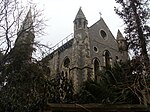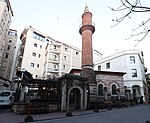Beyoğlu (Turkish pronunciation: [ˈbejoːɫu]) is a district on the European side of İstanbul, Turkey, separated from the old city (historic peninsula of Constantinople) by the Golden Horn. It was known as the region of Pera (Πέρα, meaning "Beyond" in Greek, French spelling Péra) surrounding the ancient coastal town Galata which faced Constantinople across the Horn. Beyoğlu continued to be named Pera during the Middle Ages and, in western languages, into the early 20th century.
According to the prevailing theory, the Turkish name of Pera, Beyoğlu, is a modification by folk etymology of the Venetian ambassadorial title of Bailo, whose palazzo was the most grandiose structure in this quarter. The informal Turkish-language title Bey Oğlu (literally Son of a Bey) was originally used by the Ottoman Turks to describe Lodovico Gritti, Istanbul-born son of Andrea Gritti, who was the Venetian Bailo in Istanbul during the reign of Sultan Bayezid II (r. 1481–1512) and was later elected Doge of Venice in 1523. Bey Oğlu thus referred to Lodovico Gritti, who established close relations with the Sublime Porte, and whose mansion was near the present-day Taksim Square. Located further south in Beyoğlu and originally built in the early 16th century, the "Venetian Palace" was the seat of the Bailo. The original palace building was replaced by the existing one in 1781, which later became the Italian Embassy following Italy's unification in 1861, and the Italian Consulate in 1923, when Ankara became the capital of the Republic of Turkey.The district encompasses other neighborhoods located north of the Golden Horn, including Galata (the medieval Genoese citadel from which Beyoğlu itself originated, which is today known as Karaköy), Tophane, Cihangir, Şişhane, Tepebaşı, Tarlabaşı, Dolapdere and Kasımpaşa, and is connected to the old city center across the Golden Horn through the Galata Bridge, Atatürk Bridge and Golden Horn Metro Bridge. Beyoğlu is the most active art, entertainment and nightlife centre of Istanbul.









